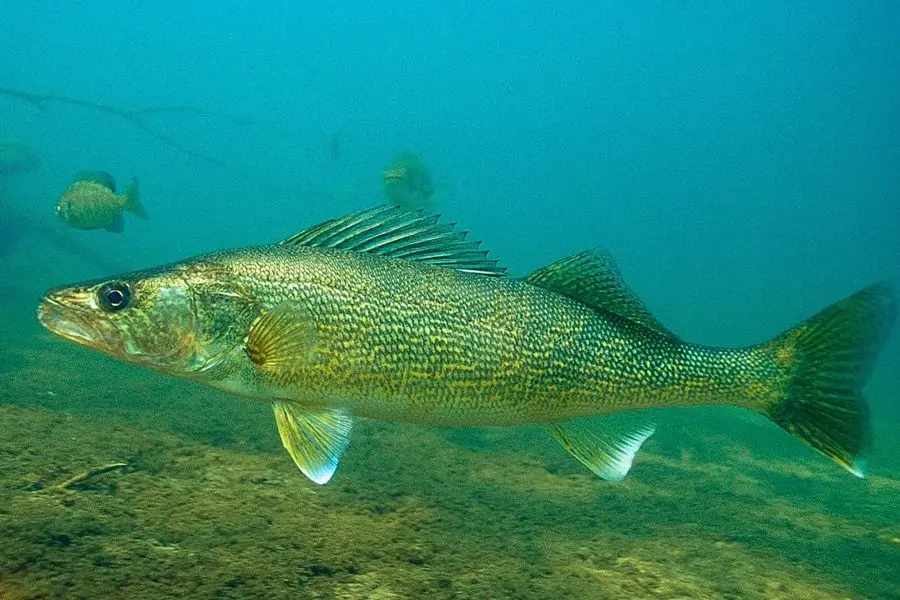SHTFPreparedness may collect a share of sales or other compensation from the links on this page.
Walleye fish are extremely popular among anglers, particularly those who enjoy fishing through the ice during the winter season. And if you have ever heard of Walleye fish, you will have likely heard mention of their teeth.
But why is this? Do they have especially sharp and dangerous teeth? Are they dangerous? Well, Walleye fish are carnivorous, and as such, they indeed have rows of long canine teeth, which impressively protrude from the upper and lower jaws.
So there is no doubt whatsoever that they have teeth, and they tend to look quite sharp! These teeth serve the purpose of allowing the Walleye fish to capture live prey while hunting, thereby preventing their escape.
However, despite appearing dangerously sharp, the teeth of a Walleye fish are actually quite rounded at the tip, not as sharp as those of a pike, for example. So as a general rule, walleye teeth are not a big threat to us humans or to our fishing lines.
Walleye Teeth Facts

To get you started on walleye teeth, here are some basic and important facts that you should be aware of:
- On average, walleye fish have between 30 and 40 canine teeth, but this depends on the size of the fish, so some can have even more!
- Walley’s long canine teeth can measure around half an inch in length!
- Walleye have a group of prominent teeth at the front end of the mouth, used to grab smaller fish when they are hunting!
- Walleye fish, just like other vertebrates, have enamel and dentine parts. They can also continuously renew them, so they can shed their teeth and regrow them, kind of like sharks!
- Walleye fish have shorter teeth in between the long canine teeth, as well as smaller ones inside the mouth cavity and on the surface of the gill rakers. That’s a lot of teeth!
- Walleye fish swallow their prey head first, so depending on how they grab it, they will have to turn it around, and their teeth keep the prey from escaping or moving while they do this!
How Sharp are Walleye’s Teeth?
Walleye fish have many teeth, which can look threatening when protruding from their mouths. But are these teeth actually all that sharp?
Given that walleye fish use their teeth to hold onto their prey, preventing them from moving or escaping, and then turn them around to swallow them headfirst, it’s safe to say that the teeth are definitely sharp.
It’s safe to say that the teeth are definitely sharp. However, they are not as razor-sharp as those of a pike, as walleye teeth have a slightly rounded top. In other words, they are sharp but not dangerously sharp.
This makes walleye fishing safer because the teeth are sharp but not as dangerous. Anglers are less likely to be bitten or hurt. That being said, if you stick your hand inside a walleye’s mouth, it will definitely hurt.
They are sharp. It’s just not sharp enough to accidentally hurt you. What we will say, which is a beneficial fact for you to know, is that smaller Walleye fish have sharper teeth than bigger Walleye fish!
This is because they have narrower, sharper teeth. So smaller walleyes are generally more dangerous than the big ones!
Can Walleye Teeth Cut the Line?
When fish have sharp teeth, one of the biggest worries for anglers is that they will be able to cut the fishing line and escape. In fact, when anglers fish for species with sharp teeth, they will often use a metal leader.
However, a Walleye’s teeth have a more rounded point, and as a general rule, they are not able to cut through a fishing line at all, so there is no worry about them doing so.
You should use a normal fishing line, just as you would with any other fish with non-sharp teeth. Some people may be inclined to use a metal leader with a walleye as a precautionary measure.
However, we strongly advise against doing so! Using a metal leader when fishing for walleye will actually put you at a disadvantage and decrease your chances of success.
The metal leader will “warn” walleyes, reducing their bite frequency due to their keen eyesight and finickiness. Instead, we recommend using a fluorocarbon leader, which is barely visible in the water and therefore won’t affect your chances of success with them.
Can a Walleye Bite You?
You should always be careful with fish, especially when handling them. However, because walleyes are known for their prominent teeth, you might also worry and fear a bite from them!
The positive news is that walleye fish rarely bite on purpose, making the likelihood of you ever receiving a bite extremely low. If you place your hand in their mouth or in close proximity, you may undoubtedly receive a bite, causing significant discomfort!
Sometimes you need to get inside the fish’s mouth to remove the hook after catching it. Especially if you’re using live bait!
Our advice: do not put your hands inside a walleye mouth. Seriously. Although their teeth have a rounded tip, they can still cause significant pain. So don’t risk it.
Instead, if you need to remove the hook, use a set of fishing pliers—ones that are long enough to reach the back of the mouth without you having to insert your hand. Plus, sometimes you can simply reach the hook through the gill slits, so you completely avoid the mouth.
Nevertheless, sometimes you just get bitten. It’s the life of an angler; after all, it’s always a small risk you take. What should you do if a walleye fish bites you? Immediately clean and disinfect the wound to prevent infection.
Use plenty of clean water, soap, or any other disinfectant product. Usually, this will be enough. But if you notice a lot of pain or a worsening in the wound, you might end up needing antibiotics! It’s always a beneficial idea to go to your doctor just to be safe.
Final Thoughts
The first rule when handling a Walleye fish is to stay away from its teeth to prevent accidental bites or injuries. In order to do this, you have to make sure you are holding the walleye correctly and in a safe manner.
And we’re going to tell you exactly how you’re supposed to hold one! The best method is to insert your fingers under the gill cover’s bottom. Then, you slide your fingers forward until you’re at the V-shaped section at the front of the walleye, and then you can pull them up to grab them safely!
You can completely avoid the mouth as a result, reducing the risk of a bite from those teeth. Once you pull the Walleye fish out of the water, use your other hand to support its weight by placing it under its belly. While you’re at it, consider posing for a photo in true angler fashion!
A point to note: if you’re planning on releasing the Walleye back into the water, make sure to not insert your fingers too far up under the gills, as it is a very sensitive area for them and might cause harm!
Alternatively, you could simply use a landing net to reduce the risk of bites or injuries! There is no direct contact, and it doesn’t harm the walleye at all! (But not great for posing.).

















